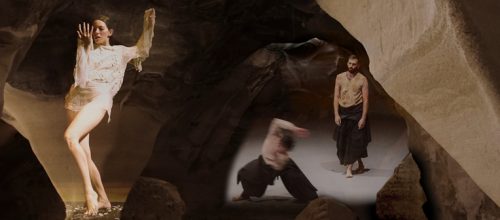
Liba Beit Guvrin Caves Exhibit
“Liba”
A video-art exhibit by Vertigo Dance Company, that was created especially for the extraordinary spaces of the Bell Cave in the Beit Guvrin – Maresha National Park, which was excavated by the ancient residents of the area.
In the core of the cave, one can hear the heart, the pulse of the earth, and in this magical place, “Liba” pulsates.
The exhibit and the site where it shall be presented unite with the movement of Noa Wertheim, Vertigo’s choreographer and artistic director, who is deeply attached to nature and the environment.
The Exhibit’s Curator: Dorit Talpaz
The interaction between the cave and movement creates a new work of art which intertwines with the viewers’ movement immediately as they enter the exhibit:
The multidimensional dance, which encompasses the viewer from every direction, through images projected onto the caves’ hidden corners and walls, expands the boundaries of the cave through movement and returns to that primal natural womb from which it was created.
“Liba” was created from Noa Wertheim’s repertoire with the Vertigo Dance Company which has been integrated into poetic video art which dances along the seam between spirit and matter – as the dancers’ bodies are projected onto the cave’s walls.
The video art was created by photographer Elad Debi and editor Gal Katzir and includes pieces of Vertigo’s repertoire over the years, including: “Pardes”, “Leela”, “Yama” and “Birth of the Phoenix”.
Beit Guvrin – Maresha National Park – World Heritage Site
The Beit Guvrin – Maresha National Park is the epicenter of the “Land of a Thousand Caves”. The Park presents an ancient architectural wonder – countless spaces, natural and man-made caves that were intended for a wide variety of uses, from dovecotes, through storage and residential purposes, to burial. In 1989 the area was declared a national park to preserve the impressive remnants of the city of Maresha and to preserve the thicket. In recognition of its rich heritage and variety of caves, the National Park was declared a World Heritage Site by UNESCO. As was defined at the 2014 declaration – “The site has outstanding universal value due to its cultural, human and environmental conservation aspects…”. Including the “Beit Guvrin – Maresha Caves Nation Park” among the prestigious list of the most important and selected sites in the world, positions Israel as a bridge between ancient cultures and as an important focal point for preserving world heritage, while uniquely connecting between past and present. The visit through the site is an extraordinary experience and offers a peek into the wonder of the values of nature, landscape and human heritage throughout history.
The Gallery in the Bell Cave
In as early as ancient times, the residents of the region identified the characteristics of the chalk subsurface. The caves were named the “Bell Caves” due to their shape, which was the result of the way they were quarried. The excavators opened a small opening at the hard top layer, and then expanded their excavation when they reached the soft layer, using iron chisels which left the diagonal digging marks that are evident on the walls of the cave. They used what was removed for construction and the huge spaces mainly served for storage but also as workshops and plastered cisterns.
